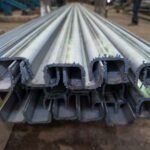Not every part of a rail coach or wagon can be thick. Or heavy. Or slow to make.
But it still has to take stress, vibration, and decades of use.
That’s where CRF—cold rolled forming—starts making sense. It’s not just about shape. It’s about control.
The way the material bends. The way it holds that shape under pressure. And how closely every profile matches the last.
If you’ve worked with steel that needs to move fast from machine to frame, this process matters more than it first appears.
CRF Turns Flat Steel Into Structural Shape
Cold-rolled forming works by feeding sheet steel through rollers that gradually form it into a precise profile. Each roller makes a small change until the full shape is achieved.
The strip starts flat. The final section might be a Z, U, Sigma, or any custom form. What matters is how cleanly that profile is made—and how repeatable the process stays across a batch.
This approach allows Indian railways suppliers to order exact-fit sections for wagon frames, roof supports, and sidewall structures. No manual bending. No correction cuts.
Cold Working Adds Strength Without Thickness
When you bend steel without heat, the material hardens at the folds. This change increases the yield strength, especially at corners and edges.
That means you can use thinner material without compromising durability. This helps wagon parts manufacturers keep weight down without giving up load-bearing performance.
It also helps with design. You can get stronger sections out of lower-gauge material, which opens up options for modular builds and lightweight sub-assemblies.
Dimensional Accuracy Makes Fit-Up Easier
Fabricated parts often need adjustment. Holes don’t line up. Surfaces warp. That’s lost time on the floor.
Cold-rolled formed sections are different. The rollers create sections that hold a tight tolerance across length, width, and bend angles.
When these sections reach the assembly line, they fit where they’re meant to—without rework.
For CRF for railway coaches, this means underframes, floor beams, and wall stiffeners land precisely into place. No surprises. No delay.
Better Sectional Design for Fatigue Management
Railway parts take stress over years. Not just weight, but vibration, braking forces, and thermal expansion.
Hot-rolled or welded assemblies sometimes introduce weak points where stress concentrates.
CRF sections help reduce that risk. The folds are continuous, the surface stays intact, and the stress spreads across the shape more evenly.
This is one reason many suppliers of railway wagon parts India prefer CRF over traditional steel angles or channels. It reduces the chance of early fatigue, especially in wagons that travel longer routes.
Adaptability for Custom Rail Projects
New coach designs often call for different support sections. Some need curved flanges. Others need asymmetric load profiles.
CRF can handle this variation through small changes in roller setup and feed rate.
Our own team at Cosmic CRF adapts profiles for both RDSO-compliant builds and export-bound designs. That includes profiles used by wagon parts manufacturers looking to standardize certain sections across multiple vehicle types.
Final Thoughts
Precision steelwork needs a balance—strength, weight, and fit. The CRF process brings all three into focus.
At Cosmic CRF, we use controlled cold-forming to supply sections built for railway demands.
Whether it’s a part of a new coach or a custom insert for a retrofitted floor, we shape steel to perform where it matters.
And we’ve seen what that precision makes possible. Get in touch with us for more information.




